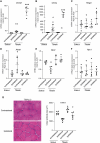Dysregulation of muscle cholesterol transport in amyotrophic lateral sclerosis
- PMID: 39197036
- PMCID: PMC11884649
- DOI: 10.1093/brain/awae270
Dysregulation of muscle cholesterol transport in amyotrophic lateral sclerosis
Abstract
Amyotrophic lateral sclerosis (ALS) is a progressive neurodegenerative disorder affecting motor neurons, with a typical lifespan of 3-5 years. Altered metabolism is a key feature of ALS that strongly influences prognosis, with an increase in whole body energy expenditure and changes in skeletal muscle metabolism, including greater reliance on fat oxidation. Dyslipidaemia has been described in ALS as part of the metabolic dysregulation, but its role in the pathophysiology of the disease remains controversial. Among the lipids, cholesterol is of particular interest as a vital component of cell membranes, playing a key role in signal transduction and mitochondrial function in muscle. The aim of this study was to investigate whether motor dysfunction in ALS might be associated with dysregulation of muscle cholesterol metabolism. We determined cholesterol content and analysed the expression of key determinants of the cholesterol metabolism pathway in muscle biopsies from 13 ALS patients and 10 asymptomatic ALS-mutation gene carriers compared to 16 control subjects. Using human control primary myotubes, we investigated the potential contribution of cholesterol dyshomeostasis to reliance on mitochondrial fatty acid. We found that cholesterol accumulates in the skeletal muscle of ALS patients and that cholesterol overload significantly correlates with disease severity evaluated by the Revised ALS Functional Rating Scale. These defects are associated with overexpression of the genes of the lysosomal cholesterol transporters Niemann-Pick type C1 (NPC1) and 2 (NPC2), which are required for cholesterol transfer from late endosomes/lysosomes to cellular membranes. Most notably, a significant increase in NPC2 mRNA levels could be detected in muscle samples from asymptomatic ALS-mutation carriers, long before disease onset. We found that filipin-stained unesterified cholesterol accumulated in the lysosomal compartment in ALS muscle samples, suggesting dysfunction of the NPC1/2 system. Accordingly, we report here that experimental NPC1 inhibition or lysosomal pH alteration in human primary myotubes was sufficient to induce the overexpression of NPC1 and NPC2 mRNA. Finally, acute NPC1 inhibition in human control myotubes induced a shift towards a preferential use of fatty acids, thus reproducing the metabolic defect characteristic of ALS muscle. We conclude that cholesterol homeostasis is dysregulated in ALS muscle from the presymptomatic stage. Targeting NPC1/2 dysfunction may be a new therapeutic strategy for ALS to restore muscle energy metabolism and slow motor symptom progression.
Keywords: disease progression; metabolism; presymptomatic stage.
© The Author(s) 2024. Published by Oxford University Press on behalf of the Guarantors of Brain.
Conflict of interest statement
The authors report no competing interests.
Figures






Comment in
-
Altered muscle cholesterol transport in ALS.Nat Rev Neurol. 2024 Nov;20(11):643. doi: 10.1038/s41582-024-01029-8. Nat Rev Neurol. 2024. PMID: 39402245 No abstract available.
References
-
- Brown RH, Al-Chalabi A. Amyotrophic lateral sclerosis. N Engl J Med. 2017;377:162–172. - PubMed
MeSH terms
Substances
LinkOut - more resources
Full Text Sources
Medical
Miscellaneous

